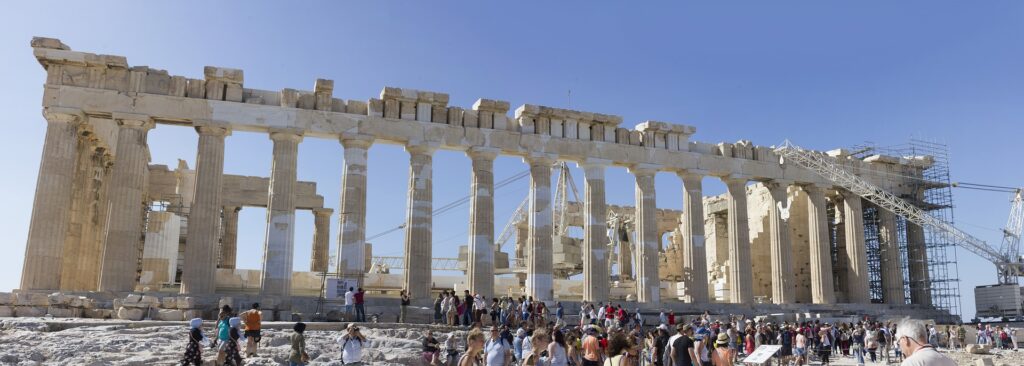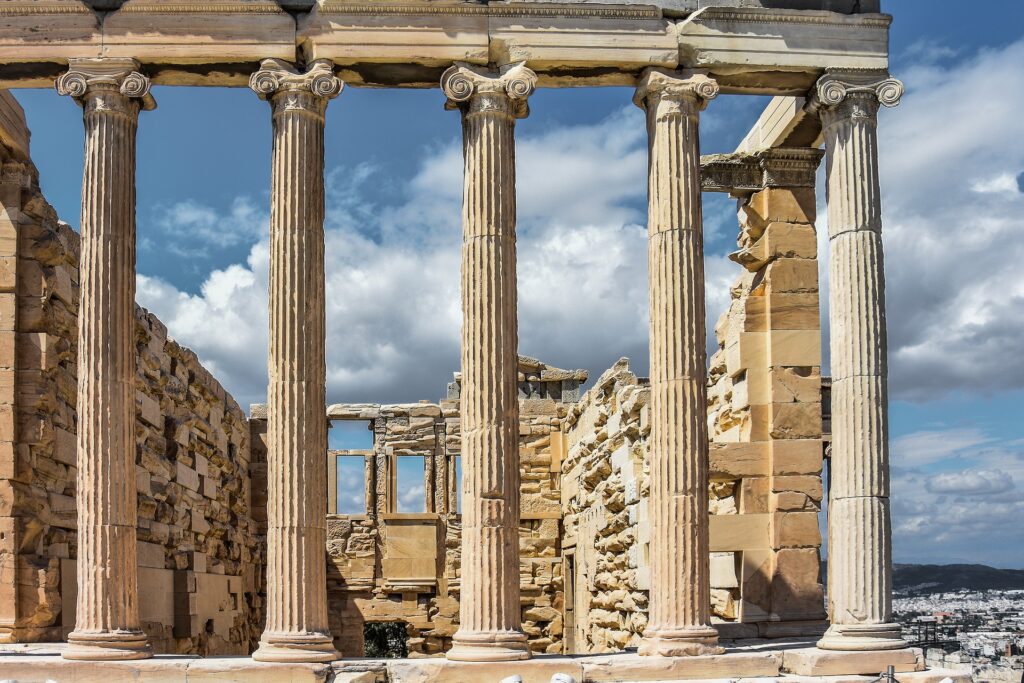Introduction
The Parthenon is iconic. Its facade has symbolized the grandeur of ancient greeks for centuries. Located on the Acropolis in Athens, Greece it was built in the 5th century BCE. It is a temple dedicated to the patron goddess Athena. It is the crown jewel of classical Greek architecture. As such it is the subject of countless studies. The style inspires artists and architects throughout the centuries.
We are going to be looking at the style that has shaped what prestige in the western world looks like. We can see how innovative and sophisticated the building methods were. In particular, we will examine the Doric order. which was the primary architectural style used in the construction of the Parthenon.
The Parthenon is a testament to the skill and creativity of the ancient Greek architects who designed and built it. They were able to create a building that was so beautiful it honored the gods. Yet, it was also so structurally sound it has passed the test of time. Taking a closer look at the temple we get a better understanding for greek society. We can gain a deeper appreciation of the achievements of ancient Greek civilization. Especially their lasting impact on the world of architecture.
Overview of the Pantheon’s architecture
The Parthenon’s architecture showcases many impressive features. Seen in impressive proportions, refined details, and harmonious balance between form and function. The temple is entirely marble. it features a rectangular floor plan with eight columns on the front and back and 17 columns on the sides. The structure is a prime example of Doric architecture. Doric architecture showcases its simplicity and strength.
The Parthenon’s design is highly innovative. The architects had an incredible understanding of perspective. They showcased several architectural features that were revolutionary for their time. The temple’s columns are not straight but slightly curved. This counteracts the illusion of sagging that parallel columns create. Additionally, the columns taper slightly towards the top. This technique is entasis. Entasis creates the illusion of greater height.
The Parthenon’s pedimental sculptures, depicting scenes from Greek mythology. These depictions are incredible and are significant architectural achievement in their own right. The sculptures are arranged in two groups. One on the east and one on the west. They depict the birth of Athena and the battle between Athena and Poseidon, respectively. When viewed from below, the sculptures show dynamic poses. They have impressive lifelike expressions and create a dramatic effect.
This genius and technical skill of the ancient Greeks draws thousands of visitors a year. We can see modern replications of the design all over the western world. The impressive engineering continues to inspire architects and artists to this day.
The Columns
The columns of the Parthenon are one of its most recognizable architectural features. There are three different types of columns used in the Parthenon: Doric, Ionic, and Corinthian. The Doric order is the most prominent style used in the Parthenon, with all but one of the columns being of the Doric order.
The Doric order is a style of column. The columns are typically fluted and have no base, with a simple capital and entablature. The columns used in the Parthenon are also wider at the bottom than they are at the top, giving them a sense of strength and stability.
The use of the Doric order in the Parthenon was a deliberate choice. They display masculinity, strength, and stability. This is a fitting decision for a temple dedicated to Athena, the goddess of wisdom, war, and strength.

Another style of column is the Ionic order. It is distinguishable by it more intricate details and a slimmer profile. Meanwhile, the Doric order is simpler and more robust. This was also reflected in other architectural styles of Ancient Greece. The Doric order was often used for temples and other public buildings. The Ionic order was often used for more decorative and ornate structures.

In addition to the Doric columns used in the Parthenon, there are also a few Ionic columns located on the porch of the Parthenon’s temple cella. These columns feature more detailed capitals and bases, with fluting that is shallower than the Doric columns.
Overall, the use of the Doric order in the Parthenon’s columns was a deliberate choice that reflected the values and ideals of Ancient Greece. The simplicity and strength of the Doric style were seen as fitting for a temple dedicated to the powerful goddess Athena.
The Frieze of the Parthenon
The frieze of the Parthenon is one of the most famous and significant features of the structure. It wraps around the top of the exterior walls of the cella, which was the inner sanctuary of the temple. The frieze depicts a procession of people, animals, and gods in a continuous narrative.
A. Description of the frieze and its placement on the Parthenon
The frieze is over 500 feet long and stands 3 feet tall, and it is a marvel of ancient Greek sculpture. It is made up of high relief sculptures, which means that the figures are carved so that they stand out from the background. The frieze is placed above the architrave and below the pediment of the Parthenon. The subject matter of the frieze is a procession, which is thought to be related to the Panathenaic festival.
B. Interpretation of the subject matter depicted in the frieze
The subject of the frieze is a procession, which is thought to be related to the Panathenaic festival. The festival was held every four years to honor Athena, the patron goddess of Athens. The procession depicted in the frieze the culmination of the festival. At this festival a new robe was presented to the statue of Athena.
C. Analysis of the sculptural style and techniques used in the frieze
The sculptural style and techniques used in the frieze are typical of the classical period of ancient Greek sculpture. The figures are depicted with idealized, perfected forms. Their drapery falls in realistic, flowing lines. The figures are depicted in action, with some figures moving forward and others turning their heads. The use of high relief allows the figures to be seen clearly from a distance. The elevation would have been important for viewers on the ground. The frieze is considered to be one of the greatest examples of ancient Greek sculpture. An incredible testament to the skill and artistry of the ancient Greeks.
The Pediments of the Parthenon
The Parthenon pediments, are a significant aspect of the building’s decorative features. The pediment is the end of the roof that sits above an entrance. Usually in the shape of a triangle, as seen on the Parthenon.

The Parthenon’s east pediment tells the story of the birth of Athena. While the west pediment depicts a scene from the battle between Athena and Poseidon for the city of Athens. The figures on the pediments are designed to be viewed from all sides. The sculptures are larger than life-size, with some figures standing up to six feet tall. The pediment sculptures, like the frieze, were made using the wet drapery technique. This style of sculpture is popular in Greek art. It is where the clothing appears transparent and clings to the body
The sculptors used chisels and other carving tools to shape the marble and create texture. Leaving areas unfinished to create the illusion of fabric folds. The end result is an intricate and detailed depiction of the human form.
The pediment sculptures are also notable for their realism and attention to detail. The sculptors captured muscles, bones, and other physical features of the human form. Using great precision, they were able to make each face lifelike and expressive. They are able to show a range of emotion.
The pediments of the Parthenon are famous for their artistry shown by the Ancient Greek sculptors. They depict scenes from Greek mythology with great realism.
The Metopes of the Parthenon
The metopes of the Parthenon are a series of decorative panels located above the columns of the temple. They are arranged in a frieze-like manner, with 92 carved in high relief panels adorning the structure. The panels are rectangular, measuring about 1.2 meters by 1 meter, and were painted with bright colors.
The metopes depict various scenes from Greek mythology. They include the Labors of Heracles, the Battle of the Lapiths and Centaurs, and the Sack of Troy. The scenes were carefully selected to convey the themes of Greek civilization. They stress the importance of civic duty, the virtues of heroism, and the consequences of hubris.
The sculptural style used in the metopes is known as the Severe Style. This style relies on its strong sense of realism and attention to detail. The figures are depicted in a naturalistic manner. Containing anatomically correct bodies and expressive facial features. The use of chiaroscuro and shading techniques creates a sense of depth and three-dimensionality to the scenes.
One of the most famous metopes is the “Sack of Troy,” which depicts the fall of the city at the end of the Trojan War. The scene shows Greek warriors attacking the city, with scenes of violence and destruction. The figures are shown in various poses, conveying a sense of frenzied action and chaos.
Another notable metope is the “Labors of Heracles,” which shows the mythical hero performing his twelve labors. The scene is depicted in a series of panels, each showing a different labor, such as the slaying of the Nemean Lion or the cleaning of the Augean Stables. The figures are shown in poses that emphasize their physical strength and prowess.
Conclusion
The Parthenon is a world-renowned ancient monument. The temple has been admired for centuries for its architectural and cultural significance. Its lasting legacy is inextricably linked to its unique design and the masterful craftsmanship of its artisans.
The Parthenon is a masterpiece of ancient Greek architecture that has stood the test of time. Its unique features, such as the columns, frieze, pediments, and metopes, continue to inspire western architecture today. The Doric order, set a standard for the classical architecture. The frieze, pediments, and metopes demonstrate the artistic mastery of the Parthenon’s sculptors.
The lasting legacy of the Parthenon’s architecture is evident in its impact on modern architecture and art. The principles of classical architecture are still relevant today. Furthermore, the temple’s cultural significance as a symbol of ancient Greek civilization has contributed to its continued popularity.
In conclusion, the Parthenon’s architecture is a testament to the skill and creativity of ancient Greek architects and artisans. Its unique design and exceptional features have inspired admiration and appreciation for centuries. The legacy of the Parthenon’s architecture is evident in its ongoing cultural and architectural influence. It remains a symbol of the enduring legacy of ancient Greek civilization.
Deeper Reading
- “The Parthenon: The Height of Greek Civilization” by Elizabeth Mann – This book includes beautiful illustrations and photographs of the Parthenon, as well as a detailed explanation of its architectural features.
- “The Parthenon Enigma” by Joan Breton Connelly – This book offers a unique perspective on the Parthenon, exploring the mysteries surrounding its construction and the symbolism behind its sculptures.
- “The Parthenon: From Antiquity to the Present” edited by Jenifer Neils – This book features a collection of essays by various scholars on different aspects of the Parthenon’s history and legacy,
